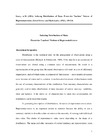| dc.contributor.creator | Leavy, Aisling | |
| dc.date.accessioned | 2019-04-08T11:46:25Z | |
| dc.date.available | 2019-04-08T11:46:25Z | |
| dc.date.issued | 2004 | |
| dc.identifier.citation | Leavy, A.M. (2004). Indexing Distributions of Data: Preservice Teachers’ Notions of Representativeness. School Science and Mathematics 104(3), 119-134. | en_US |
| dc.identifier.issn | 1949-8594 | |
| dc.identifier.uri | http://hdl.handle.net/10395/2812 | |
| dc.description | Indexing distributions of data: preservice teachers’ notions of representativeness. | en_US |
| dc.description.abstract | The purpose of the study was to identify strategies used by preservice elementary teachers to index distributions of data. A secondary purpose of the study was to investigate whether representational form influenced the type of representative values constructed. Two hundred eighty‐three preservice teachers were administered a selection of tasks requiring them to construct representative values for a variety of distributional shapes. Participants were asked to provide justifications for their chosen representative measures. Data were analyzed from two perspectives: nature and adequacy of representative measure. Results indicated that when presented with skewed data sets, over half of the participants constructed poorly representative values. Symmetric data sets were best indexed with 67% of participants constructing highly representative values. Representational form played a significant role in determining representative values. Data presented graphically were more likely to be represented using measures of variability than were those presented nongraphically. Conversely, measures of central tendency were more frequently used to represent nongraphical data. The information arising from this study indicates that many preservice teachers construct poorly representative values to index data sets and utilize identical measures of representativeness regardless of distributional shape. The findings of the study highlight the need for exploratory data activities at the preservice level, call for provision of experiences affording insights into construction of representative values, and thus, have implications for the design of preservice mathematics education curricula. | en_US |
| dc.language.iso | eng | en_US |
| dc.publisher | Wiley | en_US |
| dc.relation.ispartofseries | 104;3 | |
| dc.rights.uri | https://onlinelibrary.wiley.com/doi/full/10.1111/j.1949-8594.2004.tb17992.x | en_US |
| dc.subject | Index | en_US |
| dc.subject | Distributions | en_US |
| dc.subject | Data | en_US |
| dc.subject | Preservice teachers | en_US |
| dc.subject | Notion | en_US |
| dc.subject | Representativeness | en_US |
| dc.subject | Teaching | en_US |
| dc.subject | Education | en_US |
| dc.subject | Mathematics | en_US |
| dc.title | Indexing distributions of data: preservice teachers’ notions of representativeness (Pre-published version) | en_US |
| dc.type | Article | en_US |
| dc.type.supercollection | all_mic_research | en_US |
| dc.type.supercollection | mic_published_reviewed | en_US |
| dc.description.version | Yes | en_US |


